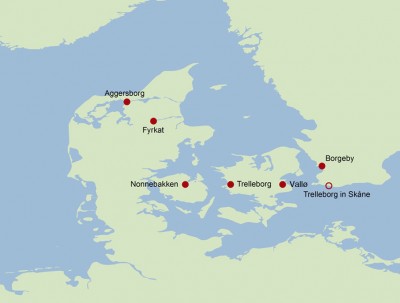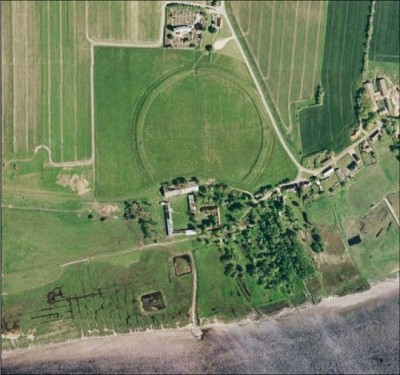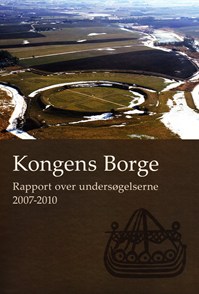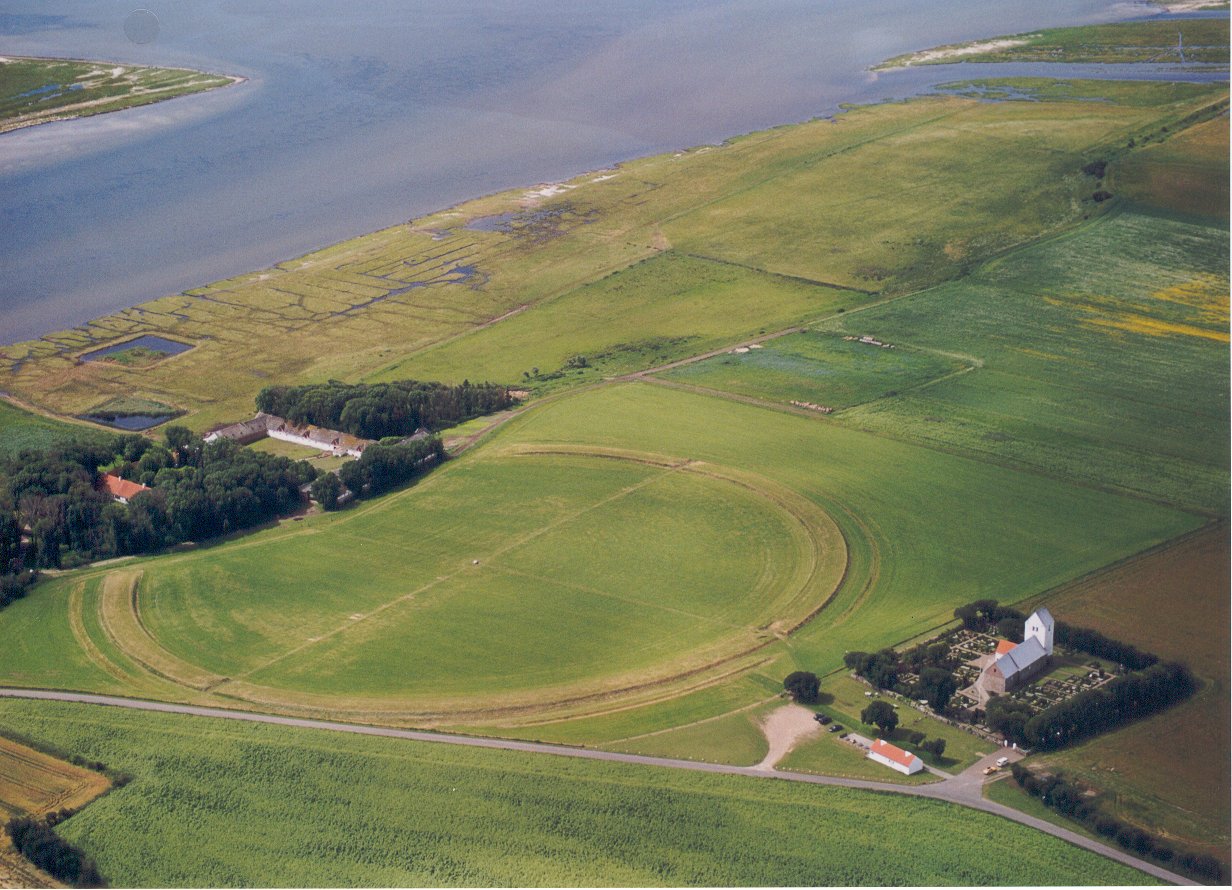Geophysical surveys shed new light on the enigmatic ring fortresses from the reign of Harold Bluetooth
The Viking Ring Fortresses from the time of Harold Bluetooth (? – 986) are impressive fortifications and witness to the power of this Viking-Age king. But how should we understand them? New geophysical surveys, conducted by a team led by Professor Søren Sindbæk and recently published, helps to answer this question.
Aggersborg
On the north coast of Limfjorden (the Firth of Lyme) lie the remains of a mighty ring fortress from the late Viking Age. The fortress lies in an area of particular strategic importance. Until around 1200 the firth was in fact a narrow belt or sound, where ships could pass through from the North Sea to Skagerak. Aggersborg was located right where the firth/belt narrows and not far from where a north-going channel was dug between Limfjorden and Jammerbugten (The Bay of Lamentation). The point of this channel was to make it possible for ships between Norway and Denmark to avoid the treacherous waters around the Northern tip of Denmark (Skagen).

The Ring Fortress belongs to a select group of at least six ring fortresses built in Denmark around this time: apart from Aggersborg, which is the largest and probably the earliest, the ring fortresses are Fyrkat, Nonneborgen, Trelleborg, Vallø Ring Fortress (a very recent find) and finally Borgeby in Scania, modern-day Sweden; (a seventh, Trelleborg in Scania is highly contested).
Aggersborg had an internal diameter of 240 m. and a ca. 8 m. wide circular rampart constructed of turf and spoil from the ditch. Internal timber constructions as well as outer cladding of wood strengthened the rampart. At the four corners of the world four massive gates opened up to the courtyard, which was cross-sectioned by paved roads into four quadrants. According to precise geometrics 48 large halls of the so-called “trelleborg-type” were placed, four by four and opening up into 12 smaller courtyards. It is obvious from archaeological excavations at Aggersborg as well as the other ring fortresses that the edifice was built to precise measurements.
The Ring Fortresses
The main purpose of the fortresses have been open for discussion since 1948 when the principal investigator, Nørlund, proposed that they were built by Swein Forkbeard as camps for his Viking army, which conquered England in the late 10th and early 11th century. However, dendrochronological dating of Trelleborg and Fyrkat pushed their construction to c. 980 and this explanation had to be abandoned. Today the ring-fortresses are generally understood as part of a whole series of impressive constructions datable to the later reign of Harold Bluetooth: the reconstruction of Dannevirke at the Southern border between Germany and Denmark (ca. 968), the building of the palisade enclosure at Jelling (ca. 968), the monumental bridge at Ravning Enge (ca. 980), and finally the ring-fortresses from ca. 970 – 80). But were they meant as the king’s fortresses designed to supress and dominate petty kingdoms (or local chieftains) and local populations? Or were they part of a strategic defence system designed to defend the realm against German, Norwegian or Swedish invaders? As written sources are sparse, answers have hitherto been rather tentative.
Geophysical Surveys
However, recent geophysical surveys carried out in 2012 by professor Søren Sivebæk in collaboration with Hannah Brown from the University of Bradford and Helen Goodchild from The University of York seem to shed further light on this conundrum. These results were recently published in an article in Internet Archaeology (Open Access).
An old manor and sunken-featured buildings
What they found was that the site, prior to the erection of the ring fortress, had been the location for first one and perhaps later a group of very large manorial farms surrounded by a massive amount of so-called sunken-huts (sunken-featured buildings) used as temporary small abodes for arts, crafts and seasonal fishing. Some of these were earlier than the fortress and appears to have been burnt down. Others were perfectly aligned with the gates of the fortress while another group was of a later date than the fortress. However, the exact degree of contemporaneity is difficult to establish at the present.

It is argued by the primary investigator of the site, Søren Sindbæk, that what we see here is the contours of an initial social landscape where a local or regional chieftain dominates the locality furnishing facilities for perhaps local gatherings (assemblies and markets) as well as places for the deliverance of corvee in the form of textile-production (primarily weaving). Seasonal fishing is also witnessed through the finds of fish-gear and might very well be another use for the some of the sunken-featured buildings. However, the main explanation seems to be the deliverance of corvée. At some point – around 970 – 980 – Aggersborg was however chosen as the locale for an impressive new form of dominance featuring one of the ring fortresses. The question is of course why this change would have to be instigated if the purpose was “only” local dominion? (Something, which the “old” social landscape now seems to document took place long before the erection of the fortress as well as afterwards, when the ring-fortress fell out of use; which happened before the turn of the millennium).
A new Defense Strategy
The answer, according to the archaeologists, is that the erection of the ring fortresses must be seen as the visible signs of a new form of social activity layering the more traditional way of exploiting the landscape. Thus, the best explanation is that the fortresses must be understood as defence structures taking part in a supra-regional effort to defend the realm against an invading enemy (whether German or Norwegian). However, strategically located at an old estate centre it seems necessary to a certain extent to consider it “a continuation of the previous institution by different means”. However, it was definitely also a “new” edifice “aligned to the political and tactical use of fortified places elsewhere in early Medieval Europe”. The authors point to the parallels offered by the Wessex Burghal System of the 9th and 10th century Anglo-Saxon England as well as the so-called “Burgenordnung” instigated by Henry I of Saxony in AD 926 against the invasion of Hungarian armies. Thus the understanding of the longer history of Aggersborg invites us to see the ring fortresses as much less part of a distinct Viking endeavour and much more in line with “those pursued by powerful rulers in challenging circumstances elsewhere in Early Medieval Europe.
One particular intriguing element here is the fact that the foundations of what might have been a high tower at Aggersborg commanding a wide view seem to document that it was just possible to “see” warning bonfires lit at high locations further into the eastern firth or sound, thus warning about a hostile navy entering the firth from the East. However the exact implications of this feature for the wider understanding of the history of the period is not directly explored in the present article and awaits further consideration
Look for it!
SOURCE:
Making Place for a Viking Fortress. An archaeological and geophysical reassessment of Aggersborg, Denmark
By Hannah Brown, Helen Goodchild and Søren M. Sindbæk
Internet Archaeology 2014, Vol. 36 issue 2 as Open Access.
Read More:
Sailing at the Limfjord. Viking Ship Museum 2010
 Aggersborg. The Viking-Age settlement and fortress
Aggersborg. The Viking-Age settlement and fortress
Ed. by Else Roesdahl, Søren Michael Sindbæk, Anne Pedersen and David M. Wilson
Series: Jysk Arkæologisk Selskabs Skrifter (Vol. 82)
Aarhus University Press 2014
Kongens Borge [The Fortresses of the King]
Rapport over undersøgelserne 2007-2010 [Report from the investigations 2007 – 2010]
Series: Jysk Arkæologisk Selskabs Skrifter ( Vol. 76)
By Andres Siegfried Dobat with contributions from Marianne Høyem Andreasen, Peter Moe Astrup, Thomas S. Bartholin, Niels Bonde, Kirsten Christensen, Mads Christian Christensen, Renée Enevold, Jesper Frederiksen, David J. Gregory, Niels Haue, Jacob Kveiborg, Jonathan Lewis, Per Thorkild Mandrup, Simon Kjær Nielsen, Kenneth Ritchie and Terje Thun
Aarhus University Press 2013
